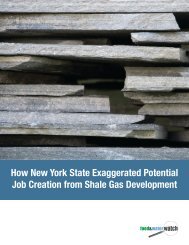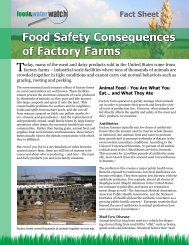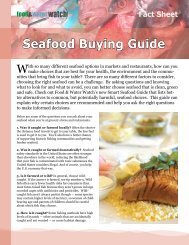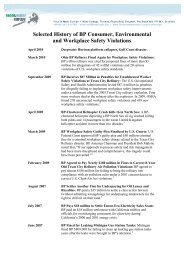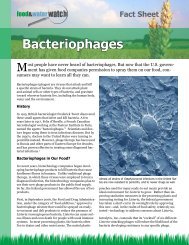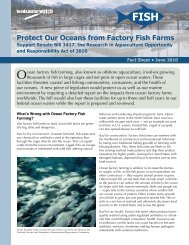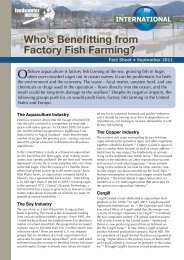Public Research, Private Gain - Food & Water Watch
Public Research, Private Gain - Food & Water Watch
Public Research, Private Gain - Food & Water Watch
Create successful ePaper yourself
Turn your PDF publications into a flip-book with our unique Google optimized e-Paper software.
investigator anonymously told the prestigious journal<br />
Nature that a Dow AgroScience employee threatened<br />
that the company could sue him if he published<br />
certain data that cast the company in a bad light. 82 A<br />
University of California professor, after reporting that<br />
transgenic material from GE crops cross-pollinated<br />
native corn varieties in Mexico, faced threats and<br />
attacks from scientists, government officials and a<br />
public relations firm with ties to industry. 83<br />
The rising importance of patents and licenses in<br />
research can stifle academic freedom and open<br />
scientific discourse. University of California, Berkeley<br />
scientists funded by Novartis were reluctant to<br />
discuss their research and collaborate with others<br />
because of Novartis’s licensing rights under the<br />
grant. 84 One Berkeley scientist noted “the little<br />
research that has been undertaken to explore unexpected<br />
and possibly harmful aspects of biotech<br />
deployment has been construed as intended to<br />
undermine Novartis-funded activities.” 85<br />
<strong>Public</strong> <strong>Research</strong> for<br />
Corporate Commercialization<br />
Corporate donors benefit from land-grant universities<br />
by poaching scientific discoveries used to<br />
develop new products. Land-grant researchers also<br />
act as contractors for food and agribusiness companies<br />
to perform product and market testing. The<br />
landmark 1980 Bayh-Dole Act pushed universities to<br />
take a more entrepreneurial role, generating revenue<br />
through producing patents that the private sector<br />
could commercialize. 86 This legislation paved the<br />
way for growing industry influence over land-grant<br />
research agendas, as schools shifted their research<br />
agendas to meet the needs of private-sector partners.<br />
<strong>Public</strong> universities provided breakthrough research<br />
in agricultural biotechnology that fueled the development<br />
of Monsanto’s signature products, recombinant<br />
Bovine Growth Hormone (rBGH) and RoundUp<br />
Ready crops. 87 Cornell University scientists invented<br />
the first genetic engineering process, but sold it to<br />
DuPont in 1990 — essentially privatizing a very valuable<br />
asset. 88 The biotech industry’s use of university<br />
research to develop highly profitable products —<br />
often of dubious benefits to farmers and consumers —<br />
is at odds with the mission of land-grant universities.<br />
These university-industry partnerships were<br />
expected to generate income for cash-strapped<br />
schools through licensing and patent earnings. In<br />
practice, corporate sponsors have captured most of<br />
the gains. Although most land-grant universities have<br />
“technology transfer” offices aimed at capitalizing on<br />
university inventions, few of these offices generate<br />
much money that can be funneled back into research<br />
programs. 89<br />
The University of California, Berkeley-Novartis<br />
collaboration exemplifies the conflicts and disappointments<br />
of university-industry partnerships.<br />
In 1998, the department of plant and microbial<br />
biology entered a $25 million funding agreement<br />
with Novartis, then the world’s largest agribusiness<br />
company (the company’s agricultural division is now<br />
owned by biotech giant Syngenta). 90<br />
Novartis received two of the five seats on the department’s<br />
research committee, allowing it to influence<br />
the department’s research agenda. 91 The company<br />
maintained the right to delay publication of research<br />
results and was also awarded licensing options<br />
to 30 percent of any innovations the department<br />
developed, even those that it didn’t fund. 92 The $25<br />
million yielded little. An external review found that<br />
the highly controversial partnership produced “few<br />
or no benefits” for either Novartis or the University of<br />
California in terms of generating patents, commercial<br />
products or income. 93<br />
9




